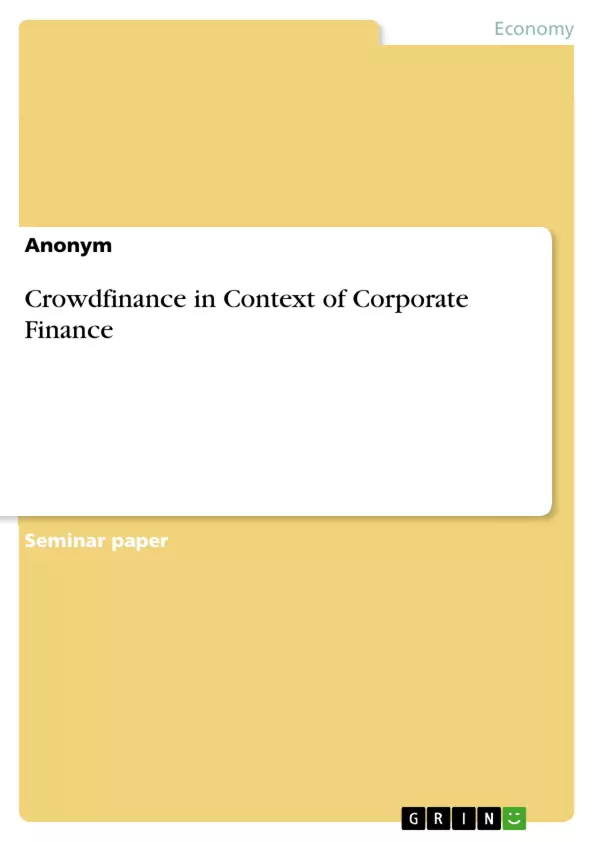Many companies transact their business processes online to enhance their effectiveness and productivity. The entire business concept of some enterprises is based on the worldwide data network. Also financial matters are more and more solved online. Bank customers are well informed by the Internet and willing to make use of different financial services of different providers simultaneously. This willingness is supported by the comparability of financial services in blogs, forums or social networks.
The services of traditional banks did not develop significantly during the last years. In contrast to this there are remarkable changes in macroeconomical, political and social surrounding conditions. Those affect the banks in a sustainable way and offer new competitors market access. Especially the availability of technology have an effect on the business activities of credit institutions, that transfer innovations only partial in turn. Simultaneously costumers show increasing experience and affinity with the handling of technology based financial services. Due to this they get a quick and easy access to information that is not available in analogue environment in that extent.
Crowdfinance has a great importance in this development. It is an alternative form of financing online, mostly for small to medium scale capital sums. Generally there is a project or business funded by a plurality of persons. The roots of crowdfinance are found in the generic category of crowdsourcing, which focus is on working with creative ideas and approaches of the crowd. Although the main features of crowdfinance go far back into the past, the subject matter moves closer into the public focus since only a few years. A reason for this popularity is amongst others the dispersion of social networks like Facebook, Twitter and innumerable blogs. By its ability to link the users among each other the Internet offers new and variegated possible applications to finance project ideas. In addition, the missing fulfilment of financing demand for small to medium scale capital sums1 as well as increasing uncertainness in international capital markets play a major role.
Inhaltsverzeichnis (Table of Contents)
- 1 Introduction
- 1.1 Problem Statement and Objective
- 1.2 Course of Analysis
- 2 Conceptual Delineation
- 2.1 From Crowdsourcing to Crowdfinance
- 2.2 The Crowd
- 2.3 Crowdfinance
- 3 Crowdfinance - A Corporate Finance Alternative?
- 3.1 Theory of Financial Intermediation
- 3.2 Monetary Recognition
- 3.2.1 Crowdinvesting (equity-based crowdfunding)
- 3.2.1.1 Definition
- 3.2.1.2 Crowdinvesting by using the Example of Seedmatch
- 3.2.1.3 Chances of Crowdinvesting for Founder and Investor
- 3.2.1.4 Risks of Crowdinvesting for Founder and Investor
- 3.2.2 Crowdlending (lending-based crowdfunding)
- 3.2.2.1 Definition
- 3.2.2.2 Crowdlending by using the Example of Auxmoney
- 3.2.2.3 Chances of Crowdlending for Founder and Investor
- 3.2.2.4 Risks of Crowdlending for Founder and Investor
- 3.3 Non-monetary Recognition
- 3.3.1 Crowdsupporting (reward-based crowdfunding)
- 3.3.1.1 Definiton
- 3.3.1.2 Crowdsupporting by using the Example of Startnext
- 3.3.1.3 Chances of Crowdsupporting for Founder and Investor
- 3.3.1.4 Risks of Crowdsupporting for Founder and Investor
- 3.3.2 Crowddonation (donation-based crowdfunding)
- 3.3.2.1 Definition
- 3.3.2.2 Crowddonation by using the Example of Betterplace.org
- 3.3.2.3 Chances of Crowddonation for Founder and Investor
- 3.3.2.4 Risks of Crowddonation for Founder and Investor
- 3.4 Factors Influencing the Use of Crowdfinance
- 3.5 Critical Examination
- The emergence of crowdfinance as an alternative to traditional financing methods.
- The different types of crowdfinance, including crowdinvesting, crowdlending, crowdsupporting, and crowddonation.
- The benefits and risks associated with crowdfinance for both investors and businesses.
- The factors that influence the use of crowdfinance in corporate finance.
- A critical examination of the potential impact of crowdfinance on the financial landscape.
Zielsetzung und Themenschwerpunkte (Objectives and Key Themes)
This seminar paper aims to explore the concept of crowdfinance in the context of corporate finance. It analyzes the various forms of crowdfinance, their application in practice, and their potential implications for both investors and businesses.
Zusammenfassung der Kapitel (Chapter Summaries)
The paper starts with an introduction, outlining the problem statement and the objective of the study. It then delves into the conceptual delineation of crowdfinance, explaining its origin and evolution from crowdsourcing. The following chapter examines crowdfinance as a potential alternative to traditional corporate finance methods, discussing the theory of financial intermediation and the various forms of crowdfinance, including crowdinvesting, crowdlending, crowdsupporting, and crowddonation. Each of these forms is illustrated with real-world examples and analyzed for its potential benefits and risks. The paper concludes with an analysis of the factors influencing the use of crowdfinance and a critical examination of its impact on the financial landscape.
Schlüsselwörter (Keywords)
Crowdfinance, Corporate Finance, Crowdinvesting, Crowdlending, Crowdsupporting, Crowddonation, Financial Intermediation, Alternative Finance, Fintech, Innovation, Risk Management, Social Finance.
- Quote paper
- Anonym (Author), 2014, Crowdfinance in Context of Corporate Finance, Munich, GRIN Verlag, https://www.grin.com/document/349771



